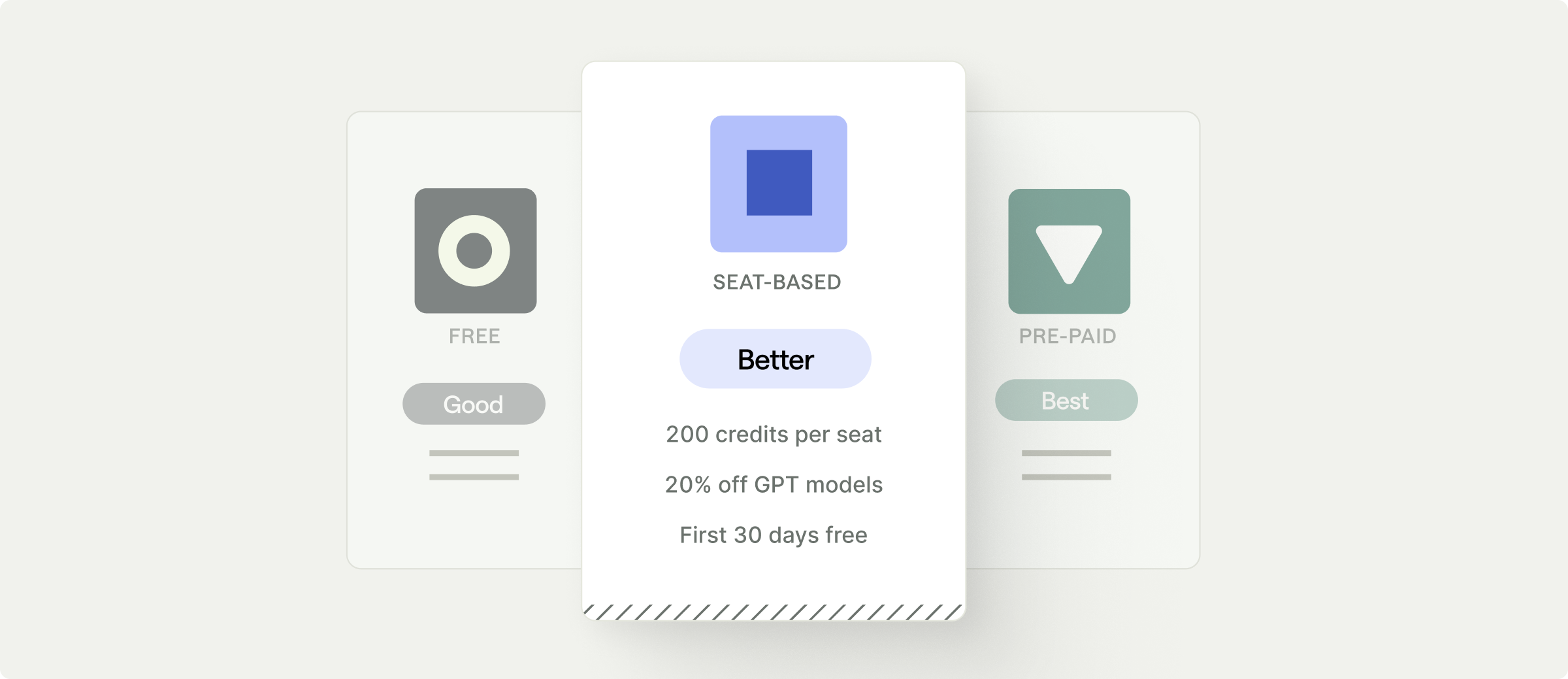Share
AI has transformed both the value software delivers and the costs to deliver it. Traditional pricing models were designed for software access, not for software doing the work. When AI performs tasks autonomously, usage becomes how customers get value. At the same time, AI products carry real infrastructure costs from day one.
This creates a new imperative: companies need monetization infrastructure that adapts as fast as their products do. They need to launch new pricing models quickly, iterate based on what they learn, and scale with confidence. Traditional billing systems weren't built for this speed.
We've launched three capabilities that let teams monetize their business end-to-end: seat-based credits to enable hybrid AI pricing, packages for encoding and entitling good-better-best PLG tiers, and account hierarchy for modeling complex SLG contracts that match how enterprise customers actually buy. Together, they create unified monetization infrastructure that handles hybrid pricing models and every go-to-market motion in one system.
Seat-based credits

Seat-based credits combine per-seat billing with usage-based consumption, letting companies assign credit allowances per user that can be pooled across an organization or scoped individually.
The economics of AI make this even more critical. AI features carry real infrastructure costs from day one—compute, model inference, storage—that scale with usage. Companies need pricing models that not only deliver value to customers but also maintain healthy unit economics. Pure per-seat pricing leaves money on the table when power users consume dramatically more resources. Pure usage pricing creates budget unpredictability that slows adoption.
Seat-based credits solve both sides of this equation. For customers, they provide budget predictability with the flexibility to explore AI features. For businesses, they ensure revenue scales with actual infrastructure costs while maintaining the familiarity of seat-based billing. This hybrid model, combining the predictable revenue of seats with consumption-based economics, lets companies profitably deliver AI capabilities without choosing between adoption and margins.
Metronome supports seat-based credit models out of the box. With seat-based credit pools, all seats contribute to a shared pool that any team member can draw from. With individual user credits, each user gets their own monthly allocation, and companies can still purchase add-on credits with pooled access across their organization.
Companies like Miro use seat-based credit pools where each paid seat contributes a set number of AI credits into one shared pool that all users can access, letting teams experiment with AI features without worrying about individual allocations. By contrast, Windsurf uses individual user credits where each user has their own monthly quota (500 credits per user on Teams plans), though purchased add-on credits are pooled across the organization. This flexibility lets companies choose the model that best fits their collaboration patterns and cost management needs.
What this enables:
- Launch AI features faster without building custom billing logic for hybrid seat-usage models
- Easily adopt an increasingly common pricing model that's complex to implement and manage without the right infrastructure
- Add AI capabilities to existing products seamlessly, reducing customer adoption friction
- Capture revenue that aligns with actual value delivered while maintaining budget predictability
Learn more about seat-based credits here and modeling subscriptions here.
Packages

Packages let teams create and manage standard pricing tiers in a good-better-best model. Teams can define these tiers in Metronome's UI or API, then provision customers instantly without engineering involvement.
This makes self-serve pricing actually work at scale. Good/better/best packaging is the standard for product-led growth because it's simple for customers to understand and easy for them to self-select. Companies like Ideogram use clear tiers (Free, Basic, Plus, Pro) where each level bundles specific features and usage limits. But with traditional billing systems, changing package pricing requires engineering support and cumbersome migrations, creating a bottleneck between business and engineering teams.
Packages eliminate this friction entirely. Non-technical teams can create and manage standard packages directly in the Metronome app. When you need to make a pricing change or roll out a new product, update the rate card and those changes automatically flow to all customers—no migrations, no manual contract edits, no engineering tickets.
What this enables:
- Launch self-serve motions faster with standard plans that make it easy for customers to buy and upgrade
- Eliminate engineering bottlenecks—non-technical teams can iterate on pricing independently
- Roll out new products instantly across your entire customer base by easily updating the rate card, while maintaining package-specific pricing
- Track which customers are on which tier and analyze revenue by package
Learn more about Packages here.
Account hierarchy

Account hierarchy enables parent–child contract structures where usage, commitments, and reporting roll up across entities within a single organization. Companies can centralize contract management while giving sub-organizations autonomy over their own budgets and usage.
This solves a persistent challenge for enterprise deals. Large organizations often operate across multiple departments and business units, each with distinct budgets and usage patterns. Managing these complex structures in traditional billing systems means duplicate contracts, reconciliation headaches, and limited visibility across the organization.
With account hierarchy, child accounts can draw down from a shared commitment while maintaining their own overage billing. This is especially valuable for AI and SaaS companies selling into complex enterprises where teams buy and use products independently. The account heirarchy capability models that complexity cleanly and keeps every billing relationship aligned under one system.
What this enables:
- Unified visibility: Consolidate billing and usage data across multiple teams or entities for clear, organization-wide reporting
- Shared commitments: Enable child accounts to draw down from a shared commit while maintaining their own overage billing
- Scalable enterprise management: Simplify contract operations for large customers managing multiple subsidiaries or divisions
Contact your Metronome representative to get started with account hierarchy.
Metronome as your monetization infrastructure
These new product capabilities give teams what they need to move fast:
- Launch hybrid pricing models out of the box
- Set up and manage PLG packages with automated provisioning
- Model complex enterprise hierarchies that match how customers buy
- Unify PLG and SLG contract management in one system
With this foundation, companies turn pricing into a growth advantage instead of a constraint.
→ Read next: Unifying Invoicing Across Every Revenue Motion
.avif)










